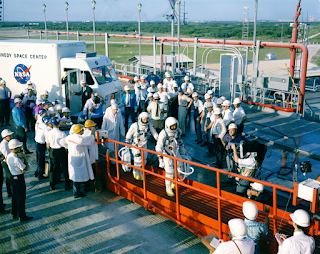Official Gemini 5 mission patch.
Fifty years ago, astronauts Gordon Cooper and Pete Conrad orbited Earth in their Gemini 5 capsule. Part of the mission had been completed (precision orbit maneuvering test) and other tests were then taken care of. There were several tests of human observation of the ground and weather. They determined that you could measure cloud tops from orbit, and were successful at watching missile test launches from space. Of course, with a mission lasting longer than a week, there were medical tests to explore and review once they returned. Before the mission, NASA had decided not to name the spacecraft on missions, but the astronauts felt that a mission patch was needed and NASA granted them to design the first official mission patch. To reflect the pioneering spirit of their flight, the astronauts chose a covered wagon and placed the slogan "8 Days or Bust" on it. NASA didn't like the slogan (what if the length was not achieved?) so a piece of white cloth was sewn over the slogan for the flight. The patch became popular, and then patches were designed for the Mercury and Gemini missions which had already flown.
Navy divers assist the astronauts after splashdown.
Gemini 5 re-entered the atmosphere on August 29, 1965 and landed 80 miles off course in the Atlantic Ocean. The error was later determined to be a wrong calculation entered into the craft's tiny computer (primitive by today's standards) by an engineer before the mission. The mission length goal had been achieved, and the crew broke the Russian record of orbital duration. For the first time the American press celebrated being ahead of the Russian program for a change.
Astronaut being lifted onto the rescue helicopter.
Capsule being hoisted onto the deck of the recovery carrier USS Lake Champlain.
The Gemini 5 capsule is today on display at Space Center Houston, in Texas.



























